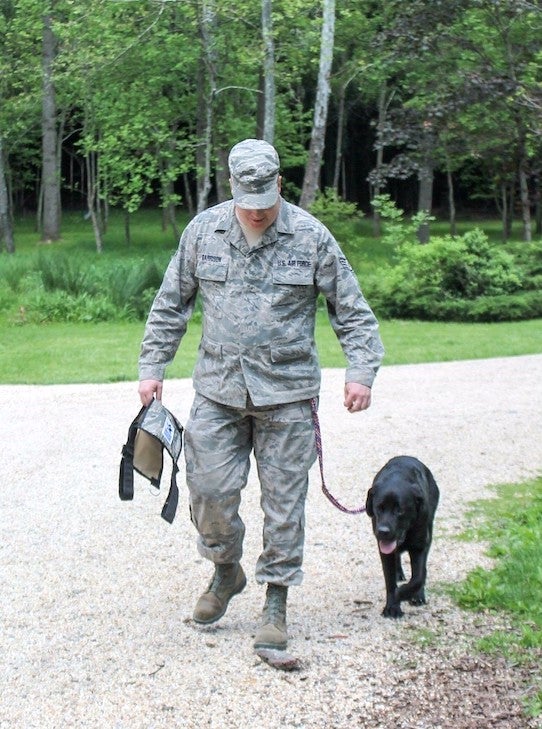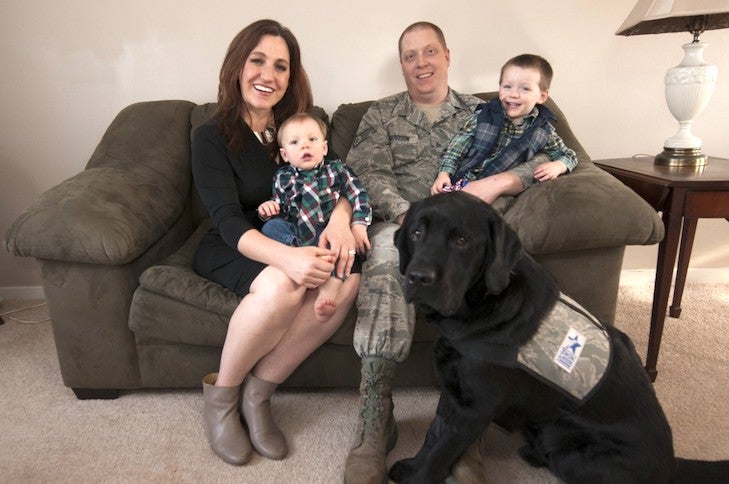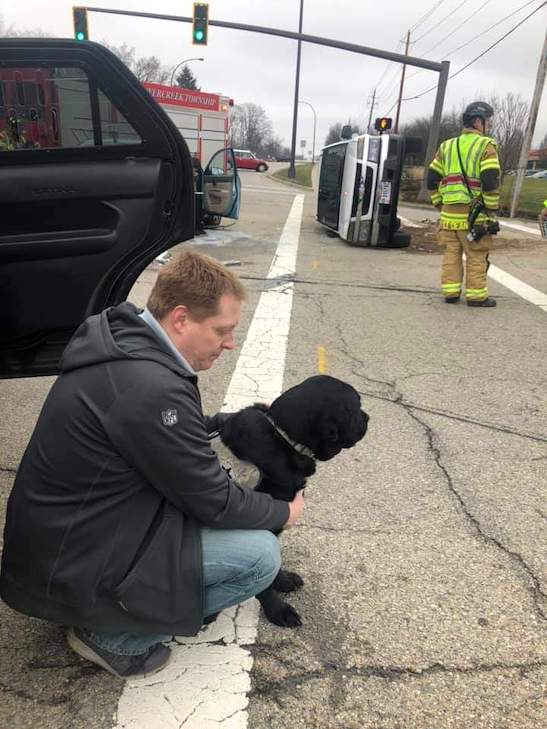
Each year, the AKC Humane Fund pays tribute to five dedicated, hardworking dogs for making significant contributions to an individual or entire community. One award is given in each of the following categories: Uniformed Service K-9, Service, Therapy, Search and Rescue, and Exemplary Companion Dog.
In a split second in 2006 Ryan Garrison’s life changed forever.
Fast forward nine years through a disquieting undercurrent of emotions and you have all the ingredients for mandating a special synergist.
Enter Luke, a Labrador Retriever, who has managed to get his Iraq War veteran on the right footing and succeed where medications fell short.
The inseparable pair, winners of the 2020 AKC ACE Service Dog award, represent a union of soul mates and a signature panache that elicits smiles from everyone around them.
But first things first since their match didn’t happen overnight and needed plenty of championing by Garrison’s wife, Julie, years ago.
When Everything Changed
Garrison’s story begins in Kirkuk, Iraq, when the now-retired Air Force Staff Sgt. E5 was walking his cargo load to a K-loader when an RPG (rocket-propelled grenade) was fired over a nearby perimeter fence. He was at the rear of the loader when it struck the front end. “The percussion blast knocked me backwards off the K-loader,” he recalls. “It tore two disks in my back and fractured two vertebrae. And I received a small cut on my arm from shrapnel.”
Upon returning stateside, other physical issues became pronounced: chest pain, rapid heartbeat, numbness in the arms. Dozens of tests showed no heart damage. Next, he was referred to a counselor to determine if it was mental, resulting in his security clearance being pulled for months.
At that point, it was suggested PTSD (Post-Traumatic Stress Disorder) might be the culprit. For the following six years he “fought through” anxiety attacks while refusing medications. “I kept telling myself I did not have PTSD.”
During that spell, Garrison’s career field, Air Transportation – loading cargo and passengers – took him to several stateside Air Force bases before he retired in 2016.

Taking Steps Toward a Service Dog
Garrison and Julie married in 2010. She was a music therapist at National Intrepid Center of Excellence, a Department of Defense organization at Walter Reed National Military Medical Center in Bethesda, Maryland focusing on the clinical care, diagnosis, research and education of military-service members with traumatic brain injuries and psychological health disorders.
At the time, he was battling the demons of PTSD. “I had all the symptoms, but did not want to admit it,” he confesses. “Medications gave me side effects, which were pretty explosive.”
Early on, he was opposed to the idea of a service dog, as it would draw attention to him and bystanders would wonder “what was wrong with me. I was not even allowing anyone I knew to see the signs of anything wrong.” In other words, he found himself in a psychological cul-de-sac without a means out.
Julie’s office at Walter Reed was right down the hallway from Warrior Canine Connections, an organization that provides specially trained service dogs to military veterans nationwide.
“She would go down and pet the puppies and talk with Rick Yount (WCC founder and executive director). Julie told a friend from church, whose husband was a combat veteran and struggling with PTSD, about Warrior Canine Connection and he became interested. At this point, I started seeing a counselor, and it wasn’t long before that friend ended up with a WCC dog, which changed his life. Once I recognized that, I began to put aside my hesitation of getting a service dog and submitted an application.
“In doing so, I reverted back to one of my characteristics I am most proud of – courage. I could do this. I could get the help I need and not care what others think. Stand tall and admit it – I needed help.”

Bringing Home Luke
It wasn’t long before Ryan and Julie did a meet-and-greet with WCC puppies in Baltimore. He recalls, “They all had colored collars for identification purposes. In that litter that day was Mr. Black, who was later sent to Palo Alto, California, for WCC general training.
Skip ahead two years and Garrison, still on active duty, began WCC training with the dogs. “I worked with five or six them, taking them to town with a trainer. Near the end of my training they brought Luke back from Palo Alto, who I found out was that puppy Mr. Black I met a couple of years earlier.”
Luke was added to the mix of young dogs Garrison was teamed with, as trainer Kaitlyn Fudge meticulously sought to find the right pairing. “She took notes as I worked with each and determined by December 2015 that Luke was a good fit for me,” he notes. After the pair worked together for a month, on February 1, 2016, Luke was sent home with Garrison, three months before his official retirement from the Air Force.
This was a bit of a departure from the WCC regimen which requires veterans to undergo two-week training boot camps. Still on active duty, Garrison was allowed to begin with monthly sessions, then weekly and finally twice a week for more advanced work.
So who named Luke?
WCC names all of its dogs after veterans – past and present. Luke is dubbed after Marine Corps First Sgt. Luke Mercardante, who was killed by a road bomb in April 2008 while serving in Afghanistan.
“Luke started healing humans as soon as he was named after Luke Mercardante,” says Yount. “Luke brought comfort to the Gold Star Mercardante family, the many veterans who helped train him in WCC’s Mission-based Trauma Recovery program, and especially to Ryan Garrison and his entire family, who regained their father and husband as they knew him.”
“Luke is an integral part of our family,” reflects Julie. “I see him as one of our sons (Mitchell, 7, and Maxwell, 5). Part of his day is walking with the boys to the school bus stop three houses down and waiting until the bus departs. In the afternoon, there is a ritual. Ryan opens the front door just before the bus returns. Luke knows the sound of the bus and is ready to head out and greet the boys on command.
“When I married Ryan he was playful and quick-witted,” says Julie. “I loved it. But he went into a dark zone, became angry, punched holes in the walls, and wasn’t the same guy I married. Luke brought him out of that.
“In essence, Luke gave me my husband back. Remember that part of the wedding vow, ‘in sickness and in health,’ well, Luke nurtured us both out of that dark zone, and for that we are eternally thankful.”

Put to the Ultimate Test
While the 7-year-old, 80-pound black Lab with a look that melts the heart, is a working service dog, he needs his family time, too. “Luke loves playing fetch, chasing the boys around the backyard and collecting sticks after a storm,” Garrison beams.
“But he’s my shadow, too. With no command he follows me room-to-room. If I leave a room while he is sleeping, you can bet he will find me within five minutes after I leave. The only time this is an issue is in the shower. And even there, you get a head pushing the curtain back so he can make sure it’s me in there.
“Sometimes I will step outside to get the mail or pick up something. If he is left behind he will whine at the door until someone lets him out.”
Their solid emotional foundation was put to the ultimate test on a cloudy, 40-degree day last January after a vehicle accident in their hometown of Beavercreek, Ohio.
Garrison, Luke, and young Maxwell were on their way home from the park when another driver ran a red light and struck their truck broadside in an intersection. A flurry of activity ensued.
“I was nervous, scared and looking for a bunker to run to,” Garrison recalls. “That’s when I felt a nudge to my side, then another one. I swiped at my side with my hand, then I got a pat on the leg. This is when I snapped out of it and realized it was Luke tapping me.”
A quick glance showed Max was OK. Within a minute, people began hitting on the front window and trying to render assistance. Next, he phoned Julie at home explained what had happened. She was on the scene within minutes.
“After hanging up, I looked at the passenger-side door I was standing on and spotted drops of blood on the fabric. I patted myself down looking for blood then I saw it, Luke was bleeding from the chin and a paw.
Eventually, Garrison was able to open the door with help from several bystanders. First priority, was getting Max out, then Luke, and finally Garrison. Due to his back injury and 35-pound lifting limit, Garrison was challenged in raising Luke out into the arms fittingly of a retired Marine alongside. Remember Luke was named for a Marine.
“Once outside the truck Luke did not run nor stop to lick his wounds. He walked over to me and took the comfort position he had been taught at WCC training. Comforting him and petting him looking for sore places took my mind off my issues and calmed me down.”
As horrid as this incident was, Garrison acknowledges, it profoundly dramatized once again how this special dog shaped this veteran’s character forever.

